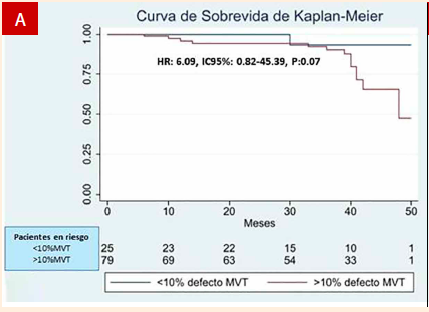Prediction of significant coronary lesions by SPECT myocardial perfusion. Results from a national reference hospital in Lima-Peru
DOI:
https://doi.org/10.47487/apcyccv.v3i2.222Keywords:
Perfusión Miocárdica, Infarto de Miocardio, PerúAbstract
Objective. To determine the discriminative capacity of myocardial perfusion with single photon emission tomography (SPECT) to predict coronary obstructions by coronary angiography. To determine mortality and major cardiovascular events at follow-up. Materials and methods. Retrospective observational study with clinical follow-up in patients undergoing SPECT and then coronary angiography. We excluded patients with myocardial infarction and percutaneous and/or surgical revascularization in the previous 6 months. Results: 105 cases were included in the study. The most commonly used SPECT protocol was pharmacological (70%). Patients with perfusion defect ≥10% of total ventricular mass (TVM) had significant coronary lesions (SCL) in 88% of cases (sensitivity 87.5% and specificity 83%). On the other hand, having ischemia ≥10% of the TVM was associated with 80% SCL (sensitivity: 72%, specificity: 65%). Clinical follow-up at 48 months evidenced that a perfusion defect ≥ 10% was predictive of major cardiovascular events (MACE) in both univariate (HR=5.3; 95%CI 1.2 - 22.2; p=0.022) and multivariate (HR= 6.1; 95%CI 1.3 - 26.9; p= 0.017) analyses. Conclusions. Having a perfusion defect ≥10% of the MVT in the SPECT study predicted with high probability and sensitivity the existence of
SCL (>80%); moreover, this group had higher MACE at follow-up.
Downloads
References
Ministerio Salud del Perú, Centro Nacional de Epidemiología, Prevención y Control de Enfermedades. Análisis de la situación de salud en el Perú 2019 [Internet]. Lima: MINSA; 2019 [citado el 11 de enero del 2022]. Disponible en: https://www.dge.gob.pe/portal/docs/asis/Asis_peru19.pdf.
Pan American Health Organization. Perú: Cardiovascular diseases profile Perú: PAHO; 2014 [citado el 15 de junio del 2022] Disponible en: http://www.paho.org/hq/index.php?option=com_docman&task=doc_download&Itemid =270&gid=27864&lang=en.
Carrillo-Larco RM, Bennett JE, Di Cesare M, Gregg EW, Bernabe-Ortiz A. The contribution of specific non-communicable diseases to the achievement of the Sustainable Development Goal 3.4 in Peru. PLoS One. 2020;15(10):e0240494. doi: 10.1371/journal.pone.0240494.
Knuuti J, Wijns W, Saraste A, Capodanno D, Barbato E, Funck-Brentano C, et al. ESC Scientific Document Group. 2019 ESC Guidelines for the diagnosis and management of chronic coronary syndromes. Eur Heart J. 2020;41(3):407-477. doi: 10.1093/eurheartj/ehz425. Erratum in: Eur Heart J. 2020;41(44):4242.
Tavakol M, Ashraf S, Brener SJ. Risks and complications of coronary angiography: a comprehensive review. Glob J Health Sci. 2012;4(1):65-93. doi: 10.5539/gjhs.v4n1p65.
Chacón-Diaz Manuel, Vega Alejandro, Aráoz Ofelia, Ríos Patricia, Baltodano Roberto, Villanueva Fernando et al. Características epidemiológicas del infarto de miocardio con elevación del segmento ST en Perú: resultados del PEruvian Registry of ST-segment Elevation Myocardial Infarction (PERSTEMI). Arch Cardiol Méx. 2018;88(5):403-412. doi: 10.1016/j.acmx.2017.11.009
Knuuti J, Ballo H, Juarez-Orozco LE, Saraste A, Kolh P, Rutjes AWS, et al. The performance of non-invasive tests to rule-in and rule-out significant coronary artery stenosis in patients with stable angina: a meta-analysis focused on post-test disease probability. Eur Heart J. 2018;39(35):3322-3330. doi: 10.1093/eurheartj/ehy267.
Dorbala S, Ananthasubramaniam K, Armstrong IS, Chareonthaitawee P, DePuey EG, Einstein AJ, et al. Single Photon Emission Computed Tomography (SPECT) Myocardial Perfusion Imaging Guidelines: Instrumentation, Acquisition, Processing, and Interpretation. J Nucl Cardiol. 2018;25(5):1784-1846. doi: 10.1007/s12350-018-1283-y.
Underwood SR, Anagnostopoulos C, Cerqueira M, Ell PJ, Flint EJ, Harbinson M, et al. British Cardiac Society; British Nuclear Cardiology Society; British Nuclear Medicine Society; Royal College of Physicians of London; Royal College of Radiologists. Myocardial perfusion scintigraphy: the evidence. Eur J Nucl Med Mol Imaging. 2004;31(2):261-91. doi: 10.1007/s00259-003-1344-5.
Shaw L, Iskandrian A. Prognostic value of gated myocardial perfusion SPECT. J Nucl Cardiol. 2004;11:171-85. doi: 10.1016/j.nuclcard.2003.12.004.
Marcassa C, Bax JJ, Bengel F, Hesse B, Petersen CL, Reyes E, et al. Clinical value, cost-effectiveness, and safety of myocardial perfusion scintigraphy: a position statement. Eur Heart J. 2008 Feb;29(4):557-63. doi: 10.1093/eurheartj/ehm607.
Muscogiuri G, Guglielmo M, Serra A, Gatti M, Volpato V, Schoepf UJ. et al. Multimodality Imaging in Ischemic Chronic Cardiomyopathy. J Imaging. 2022;8(2):35. doi: 10.3390/jimaging8020035.
Berman DS, Kang X, Slomka PJ, Gerlach J, de Yang L, Hayes SW, et al. Underestimation of extent of ischemia by gated SPECT myocardial perfusion imaging in patients with left main coronary artery disease. J Nucl Cardiol. 2007;14(4):521-8. doi: 10.1016/j.nuclcard.2007.05.008.
Kim HL, Oh SW, Lee H, Kim HJ, Kim YN, Lim WH, et al. Findings of Single-Photon Emission Computed Tomography and Its Relation with Quantitative Coronary Angiography in Patients with Significant Stenosis of the Left Main Coronary Artery. Korean J Radiol. 2018;19(1):101-110. doi: 10.3348/kjr.2018.19.1.101.
Navare SM, Mather JF, Shaw LJ, Fowler MS, Heller GV. Comparison of risk stratification with pharmacologic and exercise stress myocardial perfusion imaging: a meta-analysis. J Nucl Cardiol. 2004;11(5):551-61. doi: 10.1016/j.nuclcard.2004.06.128.
Sharaf B, Wood T, Shaw L, Johnson BD, Kelsey S, Anderson RD, et al. Adverse outcomes among women presenting with signs and symptoms of ischemia and no obstructive coronary artery disease: findings from the National Heart, Lung, and Blood Institute-sponsored Women’s Ischemia Syndrome Evaluation (WISE) angiographic core laboratory. Am Heart J. 2013 Jul;166(1):134-41. doi: 10.1016/j.ahj.2013.04.002.
Bekendam MT, Vermeltfoort IAC, Kop WJ, Widdershoven JW, Mommersteeg PMC. Psychological factors of suspect coronary microvascular dysfunction in patients undergoing SPECT imaging. J Nucl Cardiol. 2022;29(2):768-778. doi: 10.1007/s12350-020-02360-5.
Piccini JP, Horton JR, Shaw LK, Al-Khatib SM, Lee KL, Iskandrian AE, Borges-Neto S. Single-photon emission computed tomography myocardial perfusion defects are associated with an increased risk of all-cause death, cardiovascular death, and sudden cardiac death. Circ Cardiovasc Imaging. 2008;1(3):180-8. doi: 10.1161/CIRCIMAGING.108.776484.
Metz LD, Beattie M, Hom R, Redberg RF, Grady D, Fleischmann KE. The prognostic value of normal exercise myocardial perfusion imaging and exercise echocardiography: a meta-analysis. J Am Coll Cardiol. 2007;49(2):227-37. doi: 10.1016/j.jacc.2006.08.048.
Lawton JS, Tamis-Holland JE, Bangalore S, Bates ER, Beckie TM, Bischoff JM, et al. 2021 ACC/AHA/SCAI Guideline for Coronary Artery Revascularization: Executive Summary: A Report of the American College of Cardiology/American Heart Association Joint Committee on Clinical Practice Guidelines. Circulation. 2022;145(3):e4-e17. doi: 10.1161/CIR.0000000000001039. Epub 2021 Dec 9. Erratum in: Circulation. 2022;145(11):e771.

Downloads
Published
Issue
Section
License
Copyright (c) 2022 The journal is headline of the first publication, then the author giving credit to the first publication.

This work is licensed under a Creative Commons Attribution 4.0 International License.














